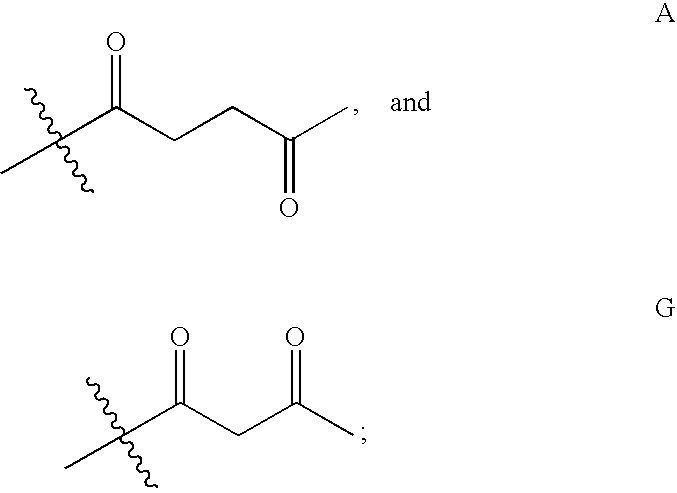Levulinic acid ester derivatives as reactive plasticizers and coalescent solvents
a technology of reactive plasticizers and ester derivatives, which is applied in the direction of textiles and paper, medical preparations, inks, etc., can solve the problems of film cracking and failure to adhere to the substrate surface, adversely affecting the balance of properties needed in a latex-based coating composition, and coating may suffer in the desired properties
- Summary
- Abstract
- Description
- Claims
- Application Information
AI Technical Summary
Benefits of technology
Problems solved by technology
Method used
Image
Examples
example 1
Synthesis of Glycerol trilevulinate (1,2,3-propanetriyl ester, 4-oxo-penanoic acid)
[0058]About 9.89 g glycerol (0.11 mol) (Aldrich), 102.6 g levulinic acid (0.88 mol) and 4 g Amberlyst 35 (Rohm and Haas) were added to a 3-neck round bottom flask equipped with a Barret style receiver, thermocouple and N2 purge. The mixture was heated at about 128° C. with stirring for about 2.5 hours. The yellow liquid mixture was cooled to room temperature, dried over anhydrous MgSO4 and contacted with activated carbon. The mixture was then washed with water. The organic layer was dried over anhydrous MgSO4 and filtered to yield a clear liquid. The product had an acid value of 0.6 and was identified by NMR analysis as Glycerol trilevulinate (1,2,3-propanetriyl ester, 4-oxo-penanoic acid).
example 2
Formulation of Polymer Composition Comprising Glycerol tri-levulinate (1,2,3-propanetriyl ester, 4-oxo-penanoic acid)
[0059]SG-10M (Rohm and Haas) polymer 50% resin solids and glycerol trilevulinate (1,2,3-propanetriyl ester, 4-oxo-penanoic acid) was mixed at levels described in Table 1 below.
TABLE 1Resin SolidsPlasticizer% Plasticizer onSample(g)(g)total solids (w / w)1100021019.1310216.7410323.1
[0060]After mixing, the samples were allowed to equilibrate overnight. Destabilization of the latex particles occurred in Sample 4 causing the sample to gel after 16 hours. Samples 1, 2 and 3 were cast into films on release paper using a 3 mil drawdown bar. The films were allowed to cure at room temperature for 96 hours. All films were transparent. Sample 3 showed presence of some exuded plasticizer on the surface of the film.
example 3
Analysis of Films by Differential Scanning Calorimetry
[0061]The films were cut into pieces and analyzed by differential scanning calorimetry. The results are given in Table 2.
TABLE 2SampleTg (° C.)125.7210.733.7
PUM
| Property | Measurement | Unit |
|---|---|---|
| Temperature | aaaaa | aaaaa |
| Temperature | aaaaa | aaaaa |
| Temperature | aaaaa | aaaaa |
Abstract
Description
Claims
Application Information
 Login to View More
Login to View More - R&D
- Intellectual Property
- Life Sciences
- Materials
- Tech Scout
- Unparalleled Data Quality
- Higher Quality Content
- 60% Fewer Hallucinations
Browse by: Latest US Patents, China's latest patents, Technical Efficacy Thesaurus, Application Domain, Technology Topic, Popular Technical Reports.
© 2025 PatSnap. All rights reserved.Legal|Privacy policy|Modern Slavery Act Transparency Statement|Sitemap|About US| Contact US: help@patsnap.com



